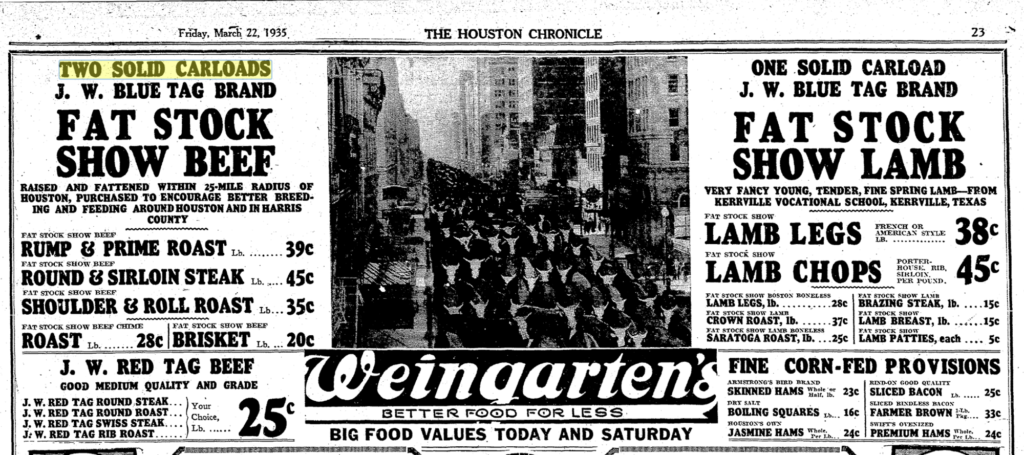A Brief History of Brisket in Houston
One of the few certainties of life in Texas is finding brisket on a barbecue menu.
This was not always the case. Brisket only became a regular menu item in the 1960s, when Midwest meatpackers made them readily available by shipping them pre-butchered in boxes to restaurants across the country.
“Boxed beef” helped brisket to overthrow beef shoulder (clod) as the quintessential Texas barbecue joint menu offering.
But brisket as a cut of beef certainly existed before the 1960s. A history of commercially-available brisket in Houston, as documented in the pages of the Houston Chronicle, goes back to early 1900s, and often paralleled the struggles and changes of a developing United States.
One of the earliest mentions of brisket is from the May 8, 1902 edition featuring an advertisement by the J.M. Geiselman butcher shop located at 417 Travis Street.
The offerings were categorized by least-to-most-expensive cuts: stews and boiling pieces (including brisket), steaks and chops, and “choicest cuts.”
Indeed, the myth and legend of brisket as a traditionally cheap cut of meat is borne out by the advertisements and recipes of the day.
During World War I, meat rationing required restaurants to serve beef only on certain days. At the time, Texans lamented the loss of beef in their then-favorite dish: chili.
From the January 31, 1918 issue of the newspaper, an article noted “there was a general wail of sorrow at the prospect of closing the chili pot on Tuesday and again on Saturday.”
Not surprisingly, local politicians, ever creative in appeasing a restless electorate, found a workaround. Chili made with the one of the cheapest cuts of beef at the time — brisket — would be exempt and available every day.
“Administrator Peden has ruled that mild chili may be served on meatless days,” announces the article. “Mild chili is an essence made from the brisket of beef, and is served as a gravy and condiment over a service of chili beans.”
In effect, the administrators were trying to stretch the cheapest ingredients they had as far as they could. To that end, chili could only be served with beans (which were essentially a filler), as specified by the administrator: “Chili shall not, in any instance, be served as an entrée by itself.”
Today, of course, Texans loath the presence of beans in chili, perhaps because it’s a latent reminder of those earlier days of war and scarcity.
By the mid-1930s, as the nation began to emerge from the Great Depression, beef became more plentiful and accessible to the average American.
Brisket in the context of barbecue cooking begins appearing in advertisements. In the July 17, 1936 issue, an ad for Kelley’s Famous Original Barbecue located at 912 Texas Street pitched, “Most delicious barbecue you ever tasted, made of lean beef brisket.”
In a full page advertisement from the March 22, 1935 issue, Weingarten’s supermarkets announces it has purchased “two solid (rail) carloads” of cattle at the Fat Stock Beef Show, the precursor to today’s Houston Livestock Show and Rodeo.
 Houston Public Library
Houston Public Library
In a remarkable photo included as part of the ad, a downtown Houston street is shown in the midst of a cattle drive, with long-horned cattle packed shoulder-to-shoulder and curb-to-curb as far as the eye can see. The ad prices “Fat stock show beef brisket” at 20 cents per pound and notes that it was “Raised and fattened within 25-mile radius of Houston.”
By the late 1930s, Weingarten’s was advertising its own barbecue menu as “Hickory smoked fancy beef barbecue … barbecued in our own pit.”
From a May 30, 1939 ad, Weingarten’s offered beef brisket at 11½ cents per pound that was “fine for barbecuing.” It was notably labeled as “Swift’s Premium” — certainly an early mention of a Midwest meatpacker making inroads into local Texas beef distribution with its own quality branding campaign, foreshadowing the revolution of boxed beef that would come some decades later.
Perhaps ominously for Texas cattlemen of the time, the price-per-pound of this industrial-scale brisket was about half the price of the local Fat Stock Beef Show brisket advertised only a few years before.

